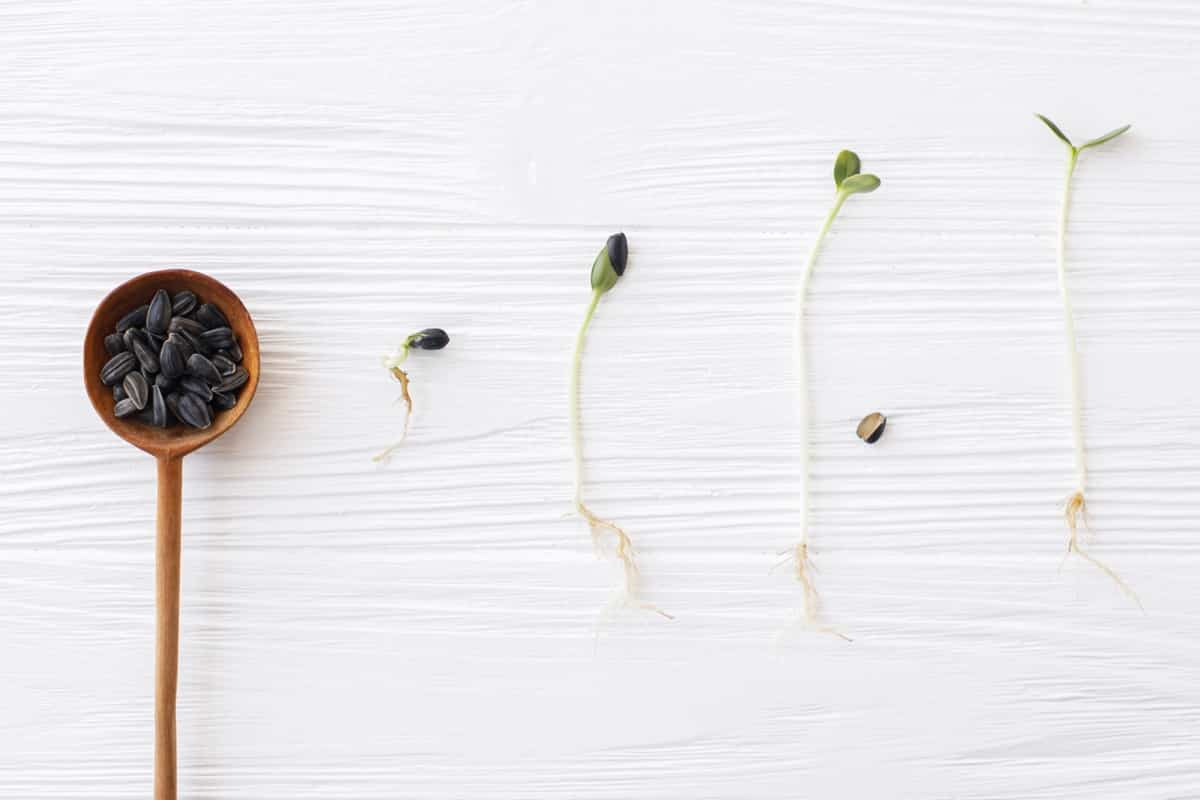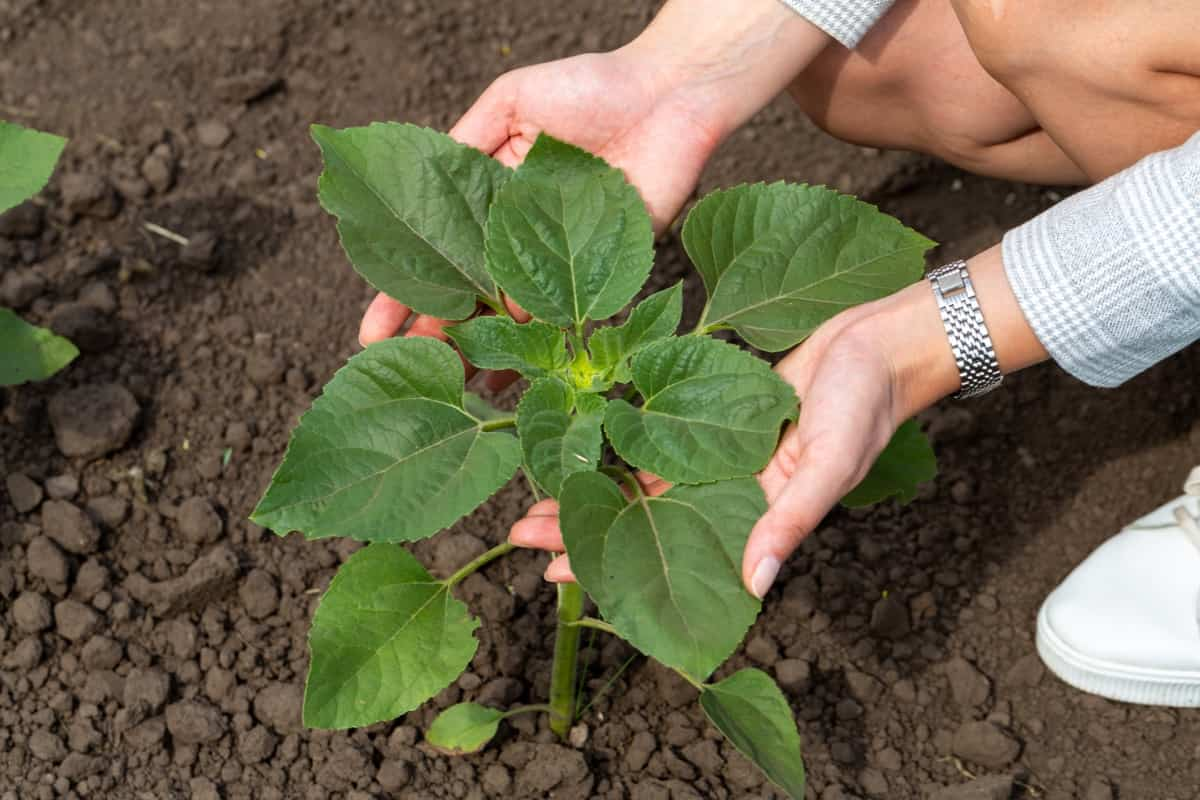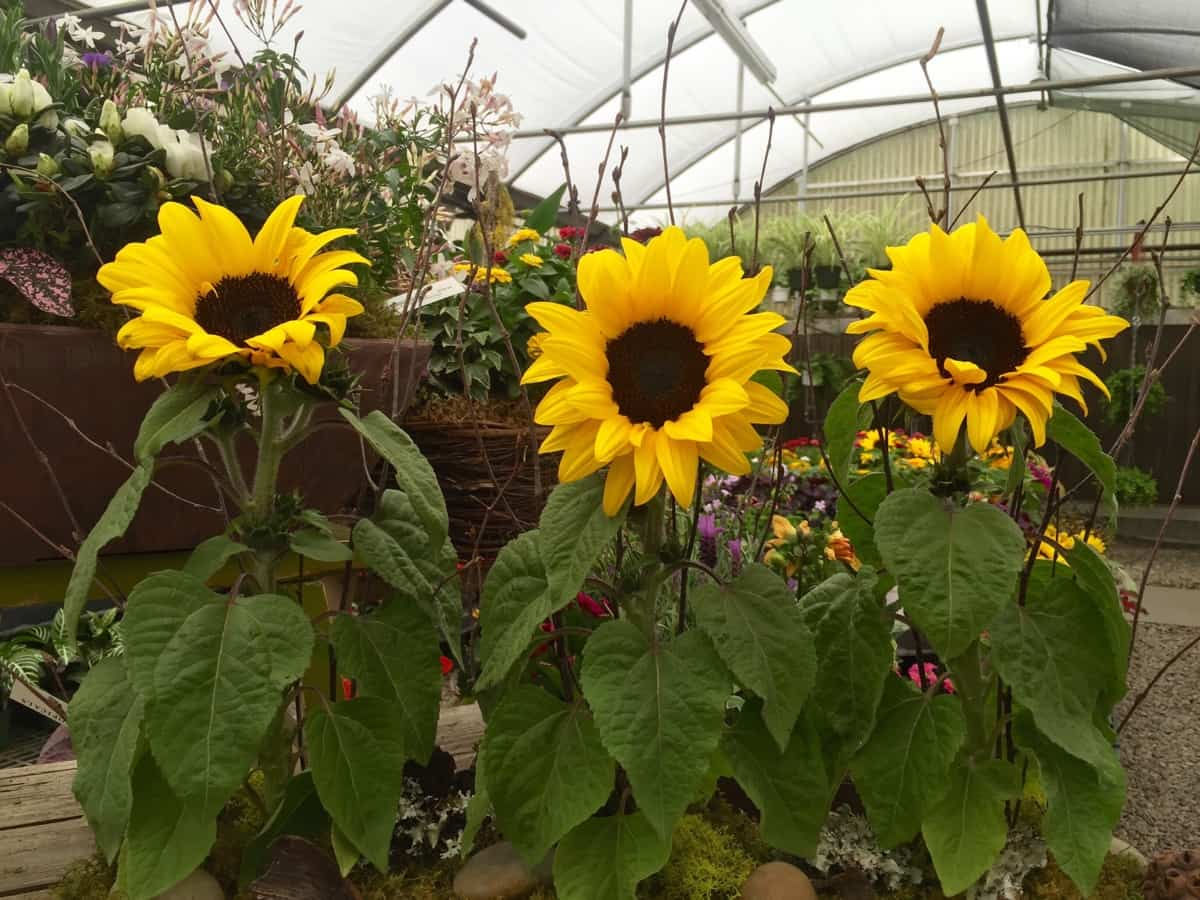Sunflowers, with their vibrant yellow petals and towering height, are a beloved symbol of summer. Witnessing the growth of sunflowers from seed to full bloom can be a fascinating experience. In this article, we will explore the different stages of sunflower growth, capturing the transformation through a time-lapse.

Growing Stages of Sunflowers
Germination Stage of Sunflower Seeds
It begins when the seed absorbs water, causing it to swell and activate the enzymes inside. The protective seed coat cracks open as the seed swells, allowing the radicle to emerge. The radicle is the plant’s first root, anchoring it into the soil. Simultaneously, the plumule, or embryonic shoot, also starts to grow and pushes its way upwards. This marks the beginning of photosynthesis, as the plumule develops leaves to capture sunlight and convert it into energy. With proper care and favorable conditions, sunflower seeds can complete this germination stage within a few days.
Seedling Development in Sunflowers
During this period, sunflower seedlings undergo rapid growth and establishment. They develop a strong root system that anchors them in the soil and absorbs nutrients and water. The shoot system also grows, forming leaves that capture sunlight for photosynthesis. Sunflowers require adequate sunlight, water, and nutrient availability for optimal seedling development. It is important to provide them with proper care, including regular watering, fertilization, and protection from pests and diseases.
Establishment of Sunflower Plants
With proper care and favorable growing conditions, the sunflower plant continues to grow and establish itself. The sunflower’s stem becomes thicker and stronger, allowing it to support the weight of the developing flower head. The plant’s root system also expands, absorbing nutrients and water from the soil to sustain growth. As the sunflower plant matures, it produces more leaves and branches, creating a lush canopy of foliage.
Vegetative Growth Phase in Sunflowers
During this phase, the sunflower plant focuses on growing its stems, leaves, and roots. Sunflowers require optimal sunlight, water, and nutrient availability to support vigorous vegetative growth. The leaves undergo photosynthesis, converting sunlight into energy for the plant’s growth.
In case you missed it: Growing Mammoth Sunflower from Seed: How to Plant Seeds, Seed Germination, Growth Stages, and Care

The stems elongate rapidly, providing structural support and transporting water and nutrients to various plant parts. The plant’s roots anchor in the soil, allowing it to absorb nutrients and water. This phase is vital for sunflowers to establish a strong foundation before transitioning to the reproductive phase.
Budding and Flowering Stage of Sunflowers
After the vegetative growth phase, sunflowers enter the budding and flowering stage. This is an exciting time when the sunflower plant prepares to produce its iconic flower heads. As a result of various environmental factors, including temperature, day length, and hormonal changes in the plant, the vegetative phase transitions to the flowering phase.
During the budding stage, small flower buds begin forming at the sunflower plant’s top. These buds contain the reproductive organs of the flower, including the stigma, style, and anthers. As the buds continue to develop, they gradually open up, revealing the vibrant petals of the sunflower.
Pollen Production and Pollination in Sunflowers
The flowering stage is crucial for pollen production and pollination in sunflowers. Pollen is produced by the anthers located within the flower head. The anthers release pollen grains, which contain the male reproductive cells necessary for fertilization. Anthers transfer pollen grains from the stigma, the female reproductive organ of the flower, during pollination. This transfer can happen through various means, including wind, insects, or even human intervention.
When pollen grains reach the stigma, they travel down the style to fertilize the ovules, resulting in seed production. Sunflowers are pollinated by butterflies, bees, and other flying insects attracted to their bright yellow petals. During nectar collection, they unwittingly transfer pollen from one flower to another, facilitating fertilization.
Seed Formation and Maturation in Sunflowers
Once pollination occurs, fertilization takes place, leading to the formation of an embryo within the ovule. The ovule then develops into a seed, while the ovary surrounding it transforms into a protective fruit called the sunflower head. As the seed matures, it undergoes changes in size, color, and composition. The endosperm, which provides nutrients to the developing embryo, diminishes, and the embryo grows.
During maturation, the seed becomes dormant, allowing it to withstand unfavorable conditions until it is ready to germinate. Overall, the process of seed formation and maturation in sunflowers is vital for reproduction and the production of viable seeds for future generations.
Sunflower Growth Time Lapse
The sunflower is a beautiful plant known for its vibrant yellow petals and impressive height. Its growth process is fascinating to observe, and a time-lapse video can capture the entire journey in a condensed form. From the moment the seed is planted, it takes approximately 10 to 15 days for the sunflower to emerge from the soil. As it continues to grow, it rapidly elongates its stem, reaching heights of up to 10 feet or more.
In case you missed it: How to Pollinate Sunflowers: Hand Pollination, Natural Pollination Methods, and Tips

The bud gradually forms and opens into a stunning flower, attracting bees and other pollinators. The entire growth cycle, from seed to fully bloomed flower, typically takes around 80 to 120 days, depending on various factors such as weather conditions and the sunflower variety.
Harvesting Time for Sunflower Seeds
The seeds should be harvested when the flower heads droop and the backs turn yellow. This usually occurs around 30 to 45 days after the flowers have fully bloomed. When the seeds are ready to harvest, gently tap the flower head and see if they fall out easily. If they do, it’s a sign that they are ripe and ready to be collected.
Cut the flower heads using sharp scissors or knives, leaving a few inches of stem attached. Ensure they are hung upside down in a dry, well-ventilated environment to fully dry. Once dried, remove the seeds from the flower heads by rubbing them gently.
Drying and Storage of Sunflower Seeds
After harvesting, sunflower seeds should be spread out in a single layer in a well-ventilated area to dry. This allows excess moisture to evaporate, preventing mold and spoilage. The drying process typically takes around two weeks but can vary depending on environmental conditions.
Once dry, the seeds should be stored in a cool, dry place to further protect them from moisture and pests. Airtight containers or sealed bags are recommended to maintain seed freshness. Regularly monitoring stored seeds is necessary to detect any signs of deterioration and take appropriate action.
Lifecycle Completion and Senescence in Sunflowers
Lifecycle senescence in sunflowers refers to the final stage of their life cycle, characterized by the gradual deterioration and decline of the plant’s physiological functions. As sunflowers age, they undergo a series of changes, including the yellowing and wilting of leaves, the withering of petals, and the plant’s eventual death.
In case you missed it: How to Grow and Care for Sunflowers: Planting Instructions

This process is influenced by various factors such as environmental conditions, genetic factors, and the availability of resources. Senescence is a natural and inevitable part of the sunflower’s life cycle, signaling the end of its reproductive phase and the preparation for seed dispersal.
Conclusion
In conclusion, the growth stages of sunflowers showcase the incredible journey of these majestic plants. From the humble beginnings of a tiny seed to the towering beauty of a fully bloomed flower, sunflowers exemplify the wonders of nature’s growth and resilience. Understanding these stages allows us to appreciate the intricate process that yields these magnificent creations.
- Feed Your Flock for Less: Top 10 Tips to Save on Chicken Feed
- Ultimate Guide to Ossabaw Island Hog: Breeding, Raising, Diet, and Care
- Hatching Answers: The Top 10 Reasons Your Chickens Aren’t Laying Eggs
- Eggs and Economics: Breaking Down the Cost of Raising Backyard Chickens
- Defend Your Greens: Proven Methods to Keep Iguanas Out of Your Garden
- Ultimate Guide to Cinnamon Queen Chicken: A Comprehensive Guide for Beginners
- Ultimate Guide to California Tan Chicken: Breeding, Raising, Diet, Egg-Production and Care
- Ultimate Guide to Marsh Daisy Chicken: Breeding, Raising, Diet, and Care
- 10 Types of Chicken Farming Businesses You Can Start for Profits